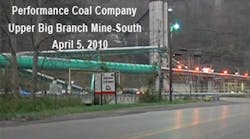A new rule revises the Mine Safety and Health Administration's pattern of violations (POV) regulation to ensure that mine operators monitor and address the most hazardous safety problems in their mines.
The POV final rule, which reflects several recommendations made by the Labor Department's Office of the Inspector General in a September 2010 report, strengthens MSHA's ability to deal with the nation's most dangerous, troubling mines and mine operators. It places the agency in a better position to identify operators that demonstrate a disregard for the health and safety of miners and have not responded to other enforcement measures.
“There has been recognition by many that the system has been broken, with no mine being placed on POV status until 2011 – 33 years after the law went into effect,” said Joseph A. Main, assistant secretary of labor – MSHA. “MSHA should not be prevented from taking action to protect the lives of miners for months, or even years, while we await the final outcome of citations and orders that a mine operator can easily contest. The new rule addresses those flaws.”
The tragedy at the Upper Big Branch Mine should not be forgotten, said Secretary of Labor Hilda L. Solis. “It exacted a terrible toll on the nation, coal miners' families and coal companies,” she noted. “Over the last 3 years, the Labor Department has undergone a serious and comprehensive evaluation of mine safety practices, and that has led to reforms to protect America's miners. The rule we are announcing today will hold mine operators accountable when they disregard life-saving safety measures.”
The final rule represents one of MSHA's highest priority regulatory initiatives, said Main, adding it addresses Congress' intent that this regulation encourage chronic violators to comply with the Mine Act and MSHA's health and safety standards.
"We think that this final rule will help prevent another tragedy such as occurred at the Upper Big Branch Mine,” added Main. “It promotes consistency in applying the POV notice as an enforcement tool, provides for a more open and transparent process, emphasizes operators' responsibility to comply with safety and health standards and monitor their own compliance, and more effectively achieves the statutory intent of the Mine Act.”
Provisions
Under the Federal Mine Safety and Health Act of 1977, MSHA is required to issue a POV notice to any mine operator that demonstrates a disregard for the health and safety of miners through a pattern of significant and substantial (S&S) violations. An S&S violation is one that contributes to a safety or health hazard that is reasonably likely to result in a reasonably serious injury or illness.
The following are among the final rule's major provisions:
- Allows MSHA to issue a POV notice without first issuing a potential POV notice.
- Eliminates the existing requirement that MSHA can consider only final orders in its POV review.
- Establishes general criteria and procedures that MSHA will use to identify mines with a pattern of S&S violations.
- Reinforces mine operators' responsibility for compliance with MSHA safety and health standards and for monitoring their mines' compliance.
- Clarifies that MSHA will consider a mine operator's effective implementation of an MSHA-approved corrective action program as a mitigating circumstance in its POV review, if the program contains definitive benchmarks implemented prior to POV notice, and the operator has reduced S&S violations.
- Restates the statutory requirement that, for mines in POV status, each S&S violation will result in a withdrawal order until a complete inspection finds no S&S violations.
The National Consumers League (NCL) commend DOL and MSHA for the new rule, saying it reinforces MSHA’s authority to respond to dangerous mining conditions and improve safety and health for miners.
“After the Upper Big Branch Mine tragedy in 2010, when 29 miners lost their lives due to management’s brazen disregard for health and safety, as well as for the law, it is gratifying to have MSHA tighten its reigns on mine operators and hold them accountable,” said Sally Greenberg, executive director of NCL, which has been advocating for improved mine safety since the 1930s.
In 2010, NCL called on MSHA to improve mine safety in order to protect the lives of workers by beefing up safety regulations, assigning higher fines for violators, and expediting processes for forcing mines with safety violations to address the hazards.
“We hope this new rule gives MSHA the authority it needs to regulate rogue operators, better protect miners, and prevent another mine disaster from occurring,” said Greenberg.
